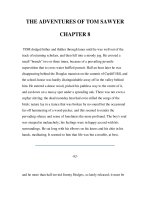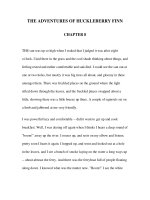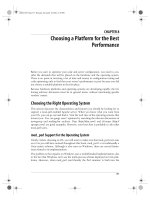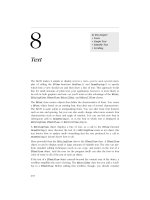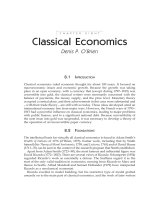Chapter 8 conjugations with the auxiliary would
Bạn đang xem bản rút gọn của tài liệu. Xem và tải ngay bản đầy đủ của tài liệu tại đây (55.13 KB, 6 trang )
CHAPTER 8. CONJUGATIONS WITH THE AUXILIARY WOULD
1. Uses of the auxiliary Would
English verbs conjugated with the auxiliary would are used in a variety of ways. For
instance, the auxiliary would is often used in polite requests and suggestions. In the
following examples, the verbs conjugated with would are underlined.
e.g. Would you please tell me the time?
Perhaps it would be a good idea to call the office.
The auxiliary would can also express a future in the past, and is used in reporting
statements and questions which pertained to the future at the time they were made.
e.g. She asked if we would help her the next day.
They said they would arrange to meet us the following week.
The auxiliary would can also be used in wishes pertaining to the future, and in the main
clauses of sentences containing false or improbable conditions. These two uses of the
auxiliary would will be discussed in the next chapter.
e.g. I wish they would help us.
It would have saved time if I had known what to do.
2. Formation of conjugations with the auxiliary Would
There are four types of conjugation formed with the auxiliary would: the Simple, the
Continuous, the Perfect, and the Perfect Continuous.
The conjugations with would are formed in the same way as the Future conjugations,
except that instead of will and shall, would and should are used. In the conjugations with
would, should may be used for the first person in British English; however, would is
normally used for the first person in American English.
Like will and shall, would is a modal auxiliary. When verbs are conjugated with modal
auxiliaries, the results are sometimes referred to as moods rather than tenses.
a. The simple conjugation with the auxiliary Would
The Simple conjugation with the auxiliary would is used to express non-continuous
actions.
In spoken English, the auxiliary would is frequently contracted to 'd. It should be noted
that this contraction is the same as that used for had.
In the case of the verb to work, the Simple conjugation with the auxiliary would is as
follows:
Without Contractions
I would work
you would work
he would work
she would work
it would work
we would work
they would work
With Contractions
I'd work
you'd work
he'd work
she'd work
it'd work
we'd work
they'd work
1
The contraction it'd is used less frequently than the other contractions, since it is more
difficult to pronounce.
As illustrated below, the word order for questions and negative statements in the Simple
conjugation with the auxiliary would is similar to that in other English conjugations. The
negative tag questions are underlined.
In spoken English, would not is frequently contracted to wouldn't.
Simple conjugation with Would
Type of Statement
Examples
Affirmative Statement:
I would work.
They would work.
Question:
Would I work?
Would they work?
Negative Statement:
I would not work.
They would not work.
Negative Question without
Would I not work?
Contractions:
Would they not work?
Negative Question with
Wouldn't I work?
Contractions:
Wouldn't they work?
Negative Tag Question:
I would work, wouldn't I?
They would work, wouldn't they?
The Simple conjugation with the auxiliary would is often used in polite requests and
suggestions.
e.g. Would you please pass the butter?
Perhaps it would be best to postpone the meeting.
In the first example, would pass is used in a polite request. In the second example, would
be is used in a polite suggestion.
b. The continuous conjugation with the auxiliary Would
The Continuous conjugation with the auxiliary would is used to express continuous,
ongoing actions.
In the case of the verb to work, the Continuous conjugation with the auxiliary would is
as follows:
I would be working
you would be working
he would be working
she would be working
it would be working
we would be working
they would be working
2
As illustrated below, the word order for questions and negative statements in the
Continuous conjugation with the auxiliary would is similar to that in other English
conjugations. The negative tag questions are underlined.
Continuous conjugation with Would
Type of Statement
Affirmative Statement:
Question:
Negative Statement:
Negative Question without
Contractions:
Negative Question with
Contractions:
Negative Tag Question:
Examples
I would be working.
They would be working.
Would I be working?
Would they be working?
I would not be working.
They would not be working.
Would I not be working?
Would they not be working?
Wouldn't I be working?
Wouldn't they be working?
I would be working, wouldn't I?
They would be working, wouldn't they?
c. The perfect conjugation with the auxiliary Would
In the case of the verb to work, the Perfect conjugation with the auxiliary would is as
follows:
I would have worked
you would have worked
he would have worked
she would have worked
it would have worked
we would have worked
they would have worked
As illustrated below, the word order for questions and negative statements in the Perfect
conjugation with the auxiliary would is similar to that in other English conjugations. The
negative tag questions are underlined.
Perfect conjugation with Would
Type of Statement
Affirmative Statement:
Question:
Examples
I would have worked.
They would have worked.
Would I have worked?
Would they have worked?
3
Negative Statement:
Negative Question without
Contractions:
Negative Question with
Contractions:
Negative Tag Question:
I would not have worked.
They would not have worked.
Would I not have worked?
Would they not have worked?
Wouldn't I have worked?
Wouldn't they have worked?
I would have worked, wouldn't I?
They would have worked, wouldn't they?
Unlike the Perfect conjugations in the English past, present, and future tenses, the Perfect
conjugation with the auxiliary would is not generally used to express an action completed
by a certain time.
Instead, the Perfect conjugation with the auxiliary would may be used as a past form of
the Simple conjugation with the auxiliary would. The verbs in the following
examples are underlined.
Present Form
I would like that.
We would write to him.
Past Form
I would have liked that.
We would have written to him.
In the first example, the Perfect conjugation would have liked is used as the past form of
the Simple conjugation would like. In the second example, the Perfect conjugation
would have written is used as the past form of the Simple conjugation would write.
d. The perfect continuous conjugation with the auxiliary Would
In the case of the verb to work, the Perfect Continuous conjugation with the auxiliary
would is as follows:
I would have been working
you would have been working
he would have been working
she would have been working
it would have been working
we would have been working
they would have been working
As illustrated below, the word order for questions and negative statements in the Perfect
Continuous conjugation with the auxiliary would is similar to that in other English
conjugations. The negative tag questions are underlined.
Perfect continuous conjugation with Would
4
Type of Statement
Affirmative Statement:
Question:
Negative Statement:
Negative Question without
Contractions:
Negative Question with
Contractions:
Negative Tag Question:
Examples
I would have been working.
They would have been working.
Would I have been working?
Would they have been working?
I would not have been working.
They would not have been working.
Would I not have been working?
Would they not have been working?
Wouldn't I have been working?
Wouldn't they have been working?
I would have been working, wouldn't I?
They would have been working, wouldn't they?
Like the Perfect conjugation with the auxiliary would, the Perfect Continuous
conjugation with the auxiliary would is not generally used to express an action completed
by a certain time.
Instead, the Perfect Continuous conjugation with the auxiliary would may be used as a
past form of the Continuous conjugation with the auxiliary would. The verbs in the
following examples are underlined.
Present Form
I would be waiting outside.
He would be helping you.
Past Form
I would have been waiting outside.
He would have been helping you.
In the first example, the Perfect Continuous conjugation would have been waiting is
used as the past form of the Continuous conjugation would be waiting. In the second
example, the Perfect Continuous conjugation would have been helping is used as the
past form of the Continuous conjugation would be helping.
3. Summary of the formation of the conjugations with the auxiliary Would
The following table summarizes the formation of the conjugations with the auxiliary
would.
Conjugation
Simple
Continuous
Perfect
Perfect Continuous
Auxiliary
would
would be
would have
would have been
Verb Form
bare infinitive
present participle
past participle
present participle
4. The "future in the past"
5
The modal auxiliary would is the past form of the modal auxiliary will. For this reason,
the auxiliary would can be used to form what is sometimes called a future in the past.
The future in the past is used in reporting statements and questions which
pertained to the future at the time they were made. In the following
examples, the verbs in the main clauses are printed in bold type, and
the verbs in the subordinate clauses are underlined.
Tense of Verb in Main Clause
Simple Present
Simple Past
Complete Sentence
I think you will succeed.
I thought you would succeed.
In the sentence I think you will succeed, the verb of the main clause, think, is in the
Simple Present, and the verb of the subordinate clause, will succeed, is in the Simple
Future. If the verb think is changed to the Simple Past, then the verb will succeed must
also be put into the past, by using the auxiliary would instead of will.
The following are other examples of the use of the future in the past:
Tense of Verb in Main Clause
Simple Present
Simple Past
Simple Present
Simple Past
Complete Sentence
She says she will visit us next week.
She said she would visit us the following week.
They know that we will be arriving tomorrow.
They knew that we would be arriving the next day.
In both pairs of examples, when the verb in the main clause is changed from the Simple
Present to the Simple Past, the verb in the subordinate clause is changed from a future
tense to the future in the past, by changing the auxiliary will to would.
It should be noted that adverb and adverb phrases such as tomorrow, yesterday and next
year can be used only with reference to present time. When used with reference to past or
future time, as in reported speech, these adverbs and adverb phrases must be changed.
For instance, tomorrow must be changed to an expression such as the next day or the
following day; and next year must be changed to an expression such as the next year or
the following year. Other examples are given in the table below.
Used with Reference to Present
Time
tomorrow
today
yesterday
next week
this week
last week
next year
this year
last year
Used with Reference to Past or Future
Time
the next day or the following day
that day or the same day
the day before or the previous day
the next week or the following week
that week or the same week
the week before or the previous week
the next year or the following year
that year or the same year
the year before or the previous year
6



